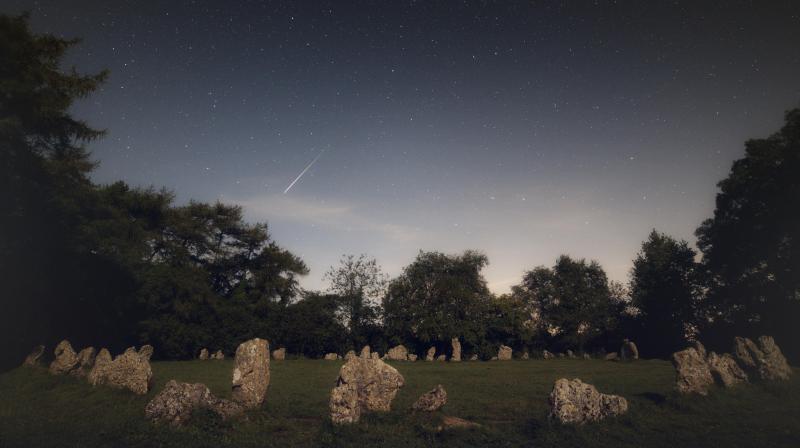2018 August 5
Here Comes the Perseid Meteor Shower

With the generally fine, clear weather that we have been experiencing across much of the British Isles, observers are reporting increasing Perseid meteor activity. The Perseids are one of the most reliable showers of the year, producing an abundance of fast, bright meteors, many with persistent trains.
This year observing conditions are ideal because there will be no interference at all by moonlight, with New Moon occurring on August 11 only two days before the peak, and the maximum occurs mainly over a weekend which is very convenient.
Video meteor observer David Dunn (Livarot, Calvados, Normandy, France) recorded his first Perseid meteor on July 16 and rates are now rising slightly night-by-night. The shower will continue to be active until about August 24. The shower’s activity displays a marked ‘kick’ around August 8-9 and steadily increasing observed rates are likely from then until the peak, which is expected at around 01h UT (02h BST) on Monday, August 13 this year. This means that the three nights of Saturday night to Sunday morning (August 11-12), Sunday night to Monday morning (August 12-13) and Monday night to Tuesday morning (August 13-14)should all be highly productive for observers in the British Isles.
Observers watching after 2100h UT on August 12-13 should experience increasing activity towards midnight and in the pre-dawn hours of August 13, as the shower radiant at RA 03h 11m, Dec. +58° (near the Double Cluster, on the Perseus-Cassiopeia border) climbs higher in the eastern sky. Activity should be starting to decline by the time darkness falls on Aug 13-14.
It is hoped that, weather permitting, observers will cover shower activity on the nights to either side of the maximum, including the Friday night to Saturday morning (August 10-11) the first night of the peak weekend. The Perseids are an ideal target for digital imaging due to the relative abundance of bright meteors, although exposures will need to be kept quite short if you are imaging from a site with any light pollution.
The best observed rates are found when the Perseid radiant is highest in the sky during the pre-dawn hours, but even in the mid-evening from 2100h the radiant is already at quite a favourable elevation above the horizon. Under cloudless skies, from a dark site, observers can expect to see between 40 and 60 meteors each hour near the peak. Even in towns or cities observed rates may still be around 10 to 20 an hour in the early morning hours when the radiant is high.
Observations in recent years have revealed noticeable variations in activity from year to year and there was a brief but well recorded outburst in Perseid rates in 2016 (see J. Brit. Astron. Assoc. 126(5), 264-265). No such enhancements are expected in 2018, but there may possibly be an encounter with an accumulation of dust grains in a mean-motion resonance at around 20h UT on August 12, although whether this will be detectable is uncertain.
We shall just have to wait and see what is in store for us in 2018.
Meteor observing should be viewed, first and foremost, as a source of enjoyment for the observer(s). Whatever the approach and specific techniques applied, meteor observing can still produce unexpected results, and the only way to make sure you don’t miss out is to go out and observe!
By whatever means you observe the Perseids this year, please submit your results to the BAA Meteor Section via meteor@britastro.org
The image at the top shows a Perseid over the Rollright Stones on 2017 Aug 13 by Steve Knight
Dr John Mason,
Director, BAA Meteor Section
| The British Astronomical Association supports amateur astronomers around the UK and the rest of the world. Find out more about the BAA or join us. |
